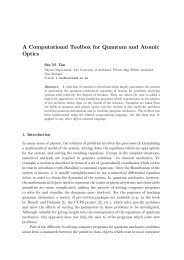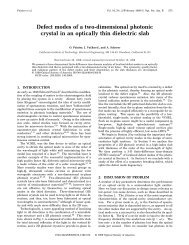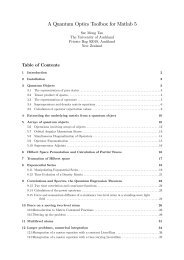Slowing and stopping light using an optomechanical crystal array
Slowing and stopping light using an optomechanical crystal array
Slowing and stopping light using an optomechanical crystal array
Create successful ePaper yourself
Turn your PDF publications into a flip-book with our unique Google optimized e-Paper software.
10<br />
heating is removed through the optical ch<strong>an</strong>nel. For high temperatures, the thermal noise scales<br />
inversely with ω m , <strong><strong>an</strong>d</strong> the use of high-frequency mech<strong>an</strong>ical oscillators ensures that the noise<br />
remains easily tolerable even at room temperature.<br />
Thermal noise in the high-frequency oscillator c<strong>an</strong> essentially be eliminated in cryogenic<br />
environments, which then enables faithful storage of single photons. Intuitively, a single-photon<br />
pulse c<strong>an</strong> be stored for a period only as long as the mech<strong>an</strong>ical decay time ∼γm<br />
−1 <strong><strong>an</strong>d</strong> as long<br />
as a noise-induced mech<strong>an</strong>ical excitation is unlikely to be generated over a region covering the<br />
pulse length <strong><strong>an</strong>d</strong> over the tr<strong>an</strong>sit time τ delay . The latter condition is equivalent to the statement<br />
that the power P ph ∼ ¯hω 1 ω in the single-photon pulse exceeds P noise . While we have focused<br />
on the static regime so far, when thermal heating is negligible, realizing P ph /P noise 1 in the<br />
static case in fact ensures that the inequality holds even when Ɣ opt (t) is time varying. Physically,<br />
the rate of Stokes scattering scales linearly with Ɣ opt while the group velocity scales inversely,<br />
<strong><strong>an</strong>d</strong> thus the probability of a noise excitation being added on top of the single-photon pulse is<br />
fixed over a given tr<strong>an</strong>sit length.<br />
In a realistic setting, the optomech<strong>an</strong>ical driving amplitude m itself will be coupled<br />
to the bath temperature, as absorption of the pump photons in the tuning cavities leads to<br />
material heating. To underst<strong><strong>an</strong>d</strong> the limitations as a qu<strong>an</strong>tum memory, we have numerically<br />
optimized the static b<strong><strong>an</strong>d</strong>width–delay product ωτ delay for a train of single-photon pulses,<br />
subject to the constraints ω < min(2 √ 2 2 m /√ Nκ ex κ in , 2(6π) 1/3 2 m /(κ exN 1/3 )), P ph /P noise ><br />
1 <strong><strong>an</strong>d</strong> γ m τ delay < 1. As a realistic model for the bath temperature, we take T b = T 0 + χα2 2 =<br />
T 0 + χ( m /h) 2 , where T 0 is the base temperature <strong><strong>an</strong>d</strong> χ ∼ 2 µK is a temperature coefficient<br />
that describes heating due to pump absorption (see the appendix). Using T 0 = 100 mK <strong><strong>an</strong>d</strong><br />
Q m = 10 5 , we find (ωτ delay ) max ∼ 110, which is achieved for parameter values N ∼ 275,<br />
κ ex /2π ∼ 1.1 GHz <strong><strong>an</strong>d</strong> m /2π ∼ 130 MHz.<br />
4. OMC design<br />
A schematic diagram showing a few periods of our proposed 2D OMC slow-<strong>light</strong> structure is<br />
given in figure 3. The structure is built around a ‘snowflake’ <strong>crystal</strong> pattern of etched holes into a<br />
silicon slab [20]. This pattern, when implemented with a physical lattice const<strong>an</strong>t of a = 400 nm,<br />
snowflake radius r = 168 nm <strong><strong>an</strong>d</strong> snowflake width w = 60 nm (see figure 3(a)), provides a<br />
simult<strong>an</strong>eous phononic b<strong><strong>an</strong>d</strong> gap from 8.6 to 12.6 GHz <strong><strong>an</strong>d</strong> a photonic pseudo-b<strong><strong>an</strong>d</strong> gap from<br />
180 to 230 THz (see the appendix). Owing to its unique b<strong><strong>an</strong>d</strong> gap properties, the snowflake<br />
patterning c<strong>an</strong> be used to form waveguides <strong><strong>an</strong>d</strong> reson<strong>an</strong>t cavities for both acoustic <strong><strong>an</strong>d</strong> optical<br />
waves simply by removing regions of the pattern. For inst<strong>an</strong>ce, a single point defect, formed<br />
by removing two adjacent holes (a so-called ‘L2’ defect), yields the co-localized phononic<br />
<strong><strong>an</strong>d</strong> photonic reson<strong>an</strong>ces shown in figures 3(b) <strong><strong>an</strong>d</strong> (c), respectively. The radiation pressure,<br />
or optomech<strong>an</strong>ical coupling between the two reson<strong>an</strong>ces, c<strong>an</strong> be qu<strong>an</strong>tified by a coupling rate,<br />
g, which corresponds to the frequency shift in the optical reson<strong>an</strong>ce line introduced by a single<br />
phonon of the mech<strong>an</strong>ical reson<strong>an</strong>ce. Numerical finite-element method (FEM) simulations of<br />
the L2 defect indicate that the mech<strong>an</strong>ical reson<strong>an</strong>ce occurs at ω m /2π = 11.2 GHz, with a<br />
coupling rate of g/2π = 489 kHz to the optical mode at frequency ω o /2π = 199 THz (freespace<br />
optical wavelength of λ 0 ≈ 1500 nm).<br />
To form the double-cavity system described in the slow-<strong>light</strong> scheme above, a pair of L2<br />
cavities are placed in the near field of each other as shown in the dashed box region of figure 3(a).<br />
Modes of the two degenerate L2 cavities mix, forming supermodes of the double-cavity system<br />
New Journal of Physics 13 (2011) 023003 (http://www.njp.org/)






